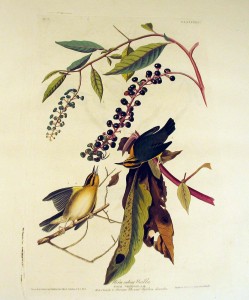 “The nest of this active little bird is formed of singular materials, being composed externally of dried mosses and the green blossoms of Hickories and Chestnut-trees, while the interior is prettily lined with fine fibrous roots, the whole apparently rather small for the size of the occupants . . .
“The nest of this active little bird is formed of singular materials, being composed externally of dried mosses and the green blossoms of Hickories and Chestnut-trees, while the interior is prettily lined with fine fibrous roots, the whole apparently rather small for the size of the occupants . . .
It is an inhabitant of the interior of the forests, and is seldom found on the borders of roads or in the fields. In spring they m0ve in pairs . . . [and] are ever amongst the decayed branches of trees or other plants, such as are accidentally broken off by the wind, and are there seen searching for insects or caterpillars.
. . . This species reaches the Central Atlantic Districts in the middle of May, and breeds there, as well as farther northward. I have found them more numerous in the Jerseys than in any other portion of the Union. In Kentucky and Ohio I have seen only a few of them; nor have I ever found their nests in either of these states.
The plant on which you see a pair of Worm-eating Warblers is well known throughout the United States by the name of Poke-berry. It grows in every situation, from the tops of the most arid mountain-ridges to the lowest and richest valleys; and it is almost impossible to follow a fence for a hundred yards without seeing some of it. Its berries are food for numerous species of our birds, and produce a beautiful dark crimson juice, which is used instead of red ink by some of the country people, although it does not retain its original colour for many days. This plant grows to a height of four or six feet, and is eaten when it first shoots from the ground as a substitute for asparagus, quantities of it being not infrequently exposed in the markets. The juice of the berries is taken in cases of ague and continued fever, but requires to be used with judgment, as too large a dose proves deleterious.”
–J. J. Audubon, Ornithological Biography, I (1831), 177-178 [excerpted].